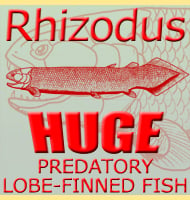Guiyu oneiros
In Depth Further Reading – The oldest articulated osteichthyan reveals mosaic gnathostome characters. – Nature 458:469-474. – M. Zhu, W. Zhao, L. Jia, J. Lu, T. Qiao & Q. Qu – 2009. – Cranial morphology of the Silurian sarcopterygian Guiyu oneiros (Gnathostomata: Osteichthyes). – Science China Earth Sciences vol 53 issue 12. – Tuo Qiao … Read more
